|
The
ASCE's Pentagon Building
Arrogant
Deception Or an Attempt to Expose a Cover-up?
by Sami
Yli-Karjanmaa
First published
Sept. 05, 2004, last updated
12/12/15
from
SamiYli-Karjanmaa Website
Abstract
This article looks at The
Pentagon Building Performance Report (January 2003)
by the American Society of Civil Engineers (available on
the internet). The key conclusion reached is
that the Report fails in its attempt to show that
the structural damage caused to the Pentagon on Sept. 11,
2001 was caused by a crash by a Boeing 757 aircraft. The main purpose of the Report seems therefore
to be to back the official, untruthful story about the
events of 9/11. However, part of the inconsistencies are
so glaring that an intention of sabotaging the said main
purpose cannot be excluded.
The key conclusion is
based on nine observations which can be divided into two
categories based on whether they concern events prior to
or during the crash of the aircraft. As regards the first
group, the overall conclusion is that the approach of the
aircraft and its being damaged cannot have taken place in
the the manner put forward in the Report. This conclusion
is supported by the following observations:
-
the aircraft's
reported 42º approach angle is not possible for
a B-757;
>>
-
the aircraft's right
wing's hitting a generator cannot account for the
narrowness and discontinuity of the damage to the
facade as proposed by the Report; >>
-
the intact cable
spools in the trajectory of the aircraft are
incompatible with the information on the impact
contained in the Report;
>> and,
-
there is no evidence
to support the claim of the left engine having
hit a vent structure; such a hit would also not
explain the narrowness of the damage to the
facade.
>>
For the second group, the
overall conclusion is that the Report's description of
the impact of the plane and of the damage caused
manifestly contradicts photographic evidence from the
scene. The description includes impossible, contradictory
and unexplained phenomena:
-
the allegation of the
aircraft's fuselage sliding into the first floor
has no physical credibility;
>>
-
the facade damage on
the right side of the opening in the outer wall
does not have anything in common with the shape,
size and position of the alleged B-757; >>
-
the facade damage on
the left side of the opening are not suggestive
of the proposed impact of a B-757; >>
-
the tail of the
aircraft left no visible marks on the facade
while the Report in no way explains this; and, >>
-
the Report fails to
provide any kind of explanation for the hole in
the wall of Ring C.
>>
The uncertainties related
to the alleged point of impact as well as the approach
angle, vertical position and inclination of the aircraft
do not weaken the conclusion presented herein that the
Pentagon could not have been hit by a Boeing 757
in the manner described in the report. This is because
changing one of these factors to allow the better
explanation of a particular damage (or the lack of it)
renders the other damage even less comprehensible.
NB. This author is aware
of theories promoted to suggest that the Pentagon was
indeed hit by a Boeing 757 which was destroyed before
it (or all of it) hit the building. While this
possibility cannot be excluded offhand - and the
conclusions about the impossibility of a B-757's crash
reached in this article may not be directly applicable to
such a case - no substantial evidence has so far been
produced to back up such a theory.
1. Introduction
"The
volume of information concerning the aircraft crash into
the Pentagon on September 11 is rather limited." (p. 12)
With this apt remark the American
Society of Civil Engineers (ASCE) starts the Pentagon
Building Performance Report's chapter that reviews the
crash information. The ASCE established
a building performance study team right away on the
afternoon of September 11, 2001. This hurry was
superfluous, however, since the whole team was allowed to
enter the site only on October 4, after the removal of
all debris. The team performed its work after this and
was able to examine the immediate post-impact situation
only from photographs
[1].
The Report, published in January 2003, is a
puzzling reading experience. It contains side by side
detailed accounts on harmless topics (such as the damage
caused to dozens of individual columns and beams or the
laboratory fire tests of columns) and passing over with
very few words things that are of key importance for the
credibility of the official story. These include, first
and foremost, the lack of facade damage where there
inevitably should have been damage.
Moreover,
there are so obvious errors and contradictions in the
Report that it is hard to regard them as unintentional.
Therefore, it must be considered one alternative that
among the authors or redactors of the report there have
been persons whose goal has been to help refute the
official story. Yet this attempt is desperate, for
professionals and the mainstream media alike do not seem
to have taken the Report into a critical examination.
The starting
point in the examination that follows has, nonetheless,
been to assume that the information provided by
the Report is correct in the absence of a specific
evidence to the contrary.
2. The Chronology of the Crash According to the ASCE
Report – Plus the Necessary Corrections
2.1. Approach of the Aircraft
2.1.1 –0.42 seconds: Why
does the report provide a false approach angle?
A
good starting point for examining the approach
angle of the aircraft is looking at the Report's
figure to the right. It shows an approaching
Boeing 757superimposed on a satellite picture.
This author has added the trajectories of the
aircraft's fuselage, engines and the wingtips as
well as the scale. The aircraft is approaching
the Pentagon approximately at the 42º angle
(with the normal of the facade) maintained by the
Report with a speed of 780 ft/s (856 km/h). The
timing of the picture is ca. 0.42 seconds before
impact.
Additionally,
arrows showing the corner of the fence bordering
the area reserved for the trailers and other
equipment of the Pentagon renovation contractors
has been added to the figure. The aircraft made a
hole in this 6-7 ft high fence that was situated
some 100 ft from the building. The inset suggests
that if the approach angle and the impact point
stated in the Report are correct, the fuselage
and the right engine of the aircraft should both
have hit the fence (this can be seen clearly from
the next picture).

This picture shows the
moment of impact as reconstructed from the data
provided by the Report: a B-757 is hitting column
line 14 (circled numbers) at the angle of 42º.
The figure shows that both the fuselage and the
right engine should have penetrated the fence.
Yet there is only one hole in it, which makes it
obvious that the angle or the point of impact is
markedly incorrect.

Of course, the Report's assertion
that the angle was 42º should not be dismissed
lightly, for it seems to have a sound basis:
"The direction of column distortion
consistently formed an angle of approximately 42
degrees with the normal to the west exterior wall
of the Pentagon." (p. 34) And there is
indeed a third possible explanation: both the
angle and the impact point may be correct if the
building was hit by an object that made only one
hole in the fence, such as a missile.
The hole created
in the facade extended column line 9 to 18
according to the Report, actually 9 to 17.
Additionally, clear facade damage apart from
broken windows was visible only at column lines
19 to 20, and the facade of the 1st floor had
lost its limestone panels from line 3 to line 8.
- "Hole" must be understood here in a
broad sense, for the outermost columns of lines
15 to 17 are still visible in photographs with
their upper ends still attached to the second
floor slab (Sources: column damage figure and the
facade damage: ASCE p. 53; the aircraft: Boeing; satellite image (on 7
Sept. 01): Space
Imaging.)

In order to establish the correct
angle the fence deserves a closer look. The figure to the
right shows that only one hole was created. The ones
below allow the determination of the location (~6 to 7 ft
from the corner) and the size (~9 to 10 ft) of the hole.
(Sources: Steve Riskus, Geoff Metcalf, Pentagon.)

Holding on to both the 42º angle and
the hole in the fence (made by the right engine)
moves the point of impact to column line 10. The
facade damage that should have been caused by the
wings should then have extended from column line
1 to line 19. Therefore it is more natural to
assume that rather the angle than the point of
impact is incorrect.
When a B-757 is put in place
using the fence hole and the impact point (see
the figure on the right), it can be seen that the
approach angle was ca. 31º instead of 42º. It
must of course be taken into account that such
small-scale pictures do not allow measurements to
be made with the precision of one degree or foot.
However, the difference in question lies multiply
outside any error margins.
At this stage it is good to
have a look at what these two approach angles
imply further away from the building. It will be
shown that, assuming the information in the
Report is otherwise correct, the 42º angle is
clearly impossible and the 31º angle means that
aircraft must have turned in a way that is not
easily reconcilable with its later tilt.
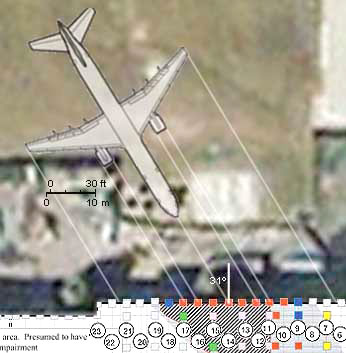
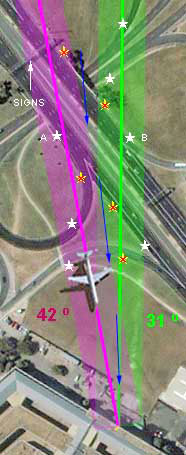 In the figure on
the right the purple line and area show the
aircraft's trajectory and the area it covered
with the Report's 42º angle, and the green ones
with the 31º angle compatible with the hole in
the fence. In both directions there are obstacles
that were left intact by the aircraft. On the
42º trajectory there are overhead signs on Route
27 about a 1000 ft (ca. 1.3 seconds) before
impact. In the figure on
the right the purple line and area show the
aircraft's trajectory and the area it covered
with the Report's 42º angle, and the green ones
with the 31º angle compatible with the hole in
the fence. In both directions there are obstacles
that were left intact by the aircraft. On the
42º trajectory there are overhead signs on Route
27 about a 1000 ft (ca. 1.3 seconds) before
impact.
There are also three intact lampposts
between them and the building. On the 31º
trajectory there is at least one lamppost that
the aircraft should necessarily have downed
(those near to the top of the photo are along a
lower road, see lamppost no. 30 below).
Eric Bart has
analyzed the downed lampposts of
which there are five according to him (the
damaged posts have been marked with yellow stars
and red X's and the closest intact ones with
white stars). Based on all this it can be
concluded that a B-757 can only have been the
cause for the downing of the lampposts if it
narrowly escaped hitting the overhead signs and
while gradually meeting the 31º trajectory by
turning to the right as the blue arrows crudely
indicate.
The main problem
that remains is that the Report says the aircraft
was at the moment of impact tilted to the left
(ca. 8º) and not to the right. The change of
tilt should have taken place within a little more
than one second in a speed of 780 ft/s. In the
figure, a B-757 is in the same place and
approaching the Pentagon at the same angle as in
the Report's figure
above.
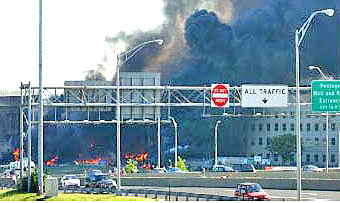 In
the picture on the right the B-757's location and
approach angle are the same as in the Report's
picture seen
above. In
the picture on the right the B-757's location and
approach angle are the same as in the Report's
picture seen
above.
The photograph on the
left has been taken rather closely along the 42º
trajectory.
As the aircraft is supposed to be
flying only a few feet from the ground, the idea
of a 42º approach angle can simply be buried on
the basis of the lampposts visible both in front
of and behind the overhead signs.
Satellite
image: Space
Imaging
The
source of the picture is lost,
but similar pictures can be seen on the
site
of the Pentagon Renovation Project.
This photograph shows that
the aircraft could not have approach directly
along the 31º trajectory, for lamppost B should
have been downed (A and B are also marked in the
picture above showing the 42º and 31º
trajectories).
Source: www.foothills-sar.ab.ca

This picture has been taken
on the bridge visible in the previous picture and
shows what most probably is the lamppost that was
downed first.
Source: Bart
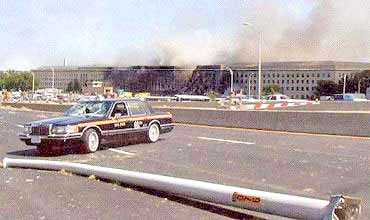
Conclusion 1:
The angle of approach,
42º, proposed by the Report, is impossible for a
Boeing 757 because of the locations of the single
hole in the fence and the intact overhead signs
and lampposts on the motorway. The only possible
trajectory is difficult to reconcile with the
Report's information on the tilt of the aircraft
at the moment of impact.
2.1.2 –0.12 seconds: Why does
the Report suggest the tip of the right wing is shattered
when the engine hits a generator?
According to the
eyewitnesses cited in the Report both engines of the
aircraft hit something before the impact, and this is
offered as an explanation for the explicitly stated fact
that the outermost parts of the wings never made contact
with the facade. The right engine is said to have hit a
750-kW generator, situated near the corner of the
fenced-in area. An employee of the Pentagon renovation
project, Mr. Frank Probst says the tip of the
right wing cut through the generator. The other
eyewitness, Mr. Don Mason, only says the wing hit the
generator.
[2]
 
As the pictures above
[sources: ASCE Report (left); Geoff Metcalf (right)] and the impact diagrams (42º,
31º) show, the facade was not damaged in the
place where the outermost part of the right wing should have hit.
This is also clearly acknowledged in the Report. It is
worth quoting precisely what the Report says about the
only possible explanation it offers for this phenomenon
(pp. 35-36):
"In any
event, the evidence suggests that the tips of both
wings did not make direct contact with the facade of
the building and that portions of the wings might
have been separated from the fuselage before the
aircraft struck the building. This is consistent with
the eyewitness statements that the right wing struck
a large generator before the aircraft struck the
building and that the left engine struck a
ground-level, external vent structure.
It is possible
that these impacts which occurred not more than 100
ft before the nose of the aircraft struck the
building, may have damaged the wings and cause debris
to strike the Pentagon facade and the heliport
control building."
With the speed stated in the Report
(780 ft/s, i.e. 856 km/h) the engine hit the generator
ca. 0.08 seconds before the nose and ca. 0.16 seconds
before the tip of the wing (should have) hit the
building. As it will be shown below, of the ca. 37-foot
long part of the wing lying outside the engine only a
disconnected part can have hit the building; the damage
is restricted between column lines 18 and 21 and spans an
area some 21 to 26 ft wide.
The wing had to be totally
disconnected from the fuselage and lose at least ca. 8 ft
of its length (13 ft, if the Report's 42º approach angle
were accepted) in 0.16 seconds. The figure on the right
is from the Report; the dimensions of the B-757 are not
quite the
real ones. Note the marking of the outermost column
of line 18 with blue color here as in the diagrams above;
this issue will be returned to below.
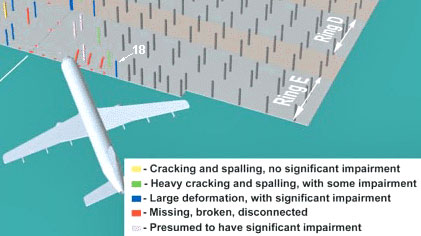
The Report mentions no
object that the tip of the right wing could have hit
before making contact with the facade, and no picture
taken on the sport seems to show such an object.
Moreover, it must be noted that no object could have
dematerialized or vaporized the wingtip upon impact.
Instead, any obstacle should either change the direction
of the (tip of the) wing or decelerate it greatly in
order to prevent it from hitting the building. For
comparison: fully stopping a body from the speed of the
aircraft in 0.16 seconds would require a deceleration of
almost 1500 m/s2. In other words, the force needed
would have to be more than 150g, i.e. over 150
times the gravity of the body.
But could it be that hitting the generator
separated the wing from the fuselage and turned
it so that its projection in the direction of the
wall narrowed down to 21 to 26 ft? [3] The most serious problem
of this fully fantastic scenario is that the wing
would have had to break at an unlogical point,
clearly beyond the engine even though the point
of the engine would be the most natural one given
the backward impact experienced by the engine
upon hitting the generator.
There are different
alternative theories as regards the fate of any
portions of the wings that did not penetrate the
building; see e.g. Dewdney
and Longspaugh.
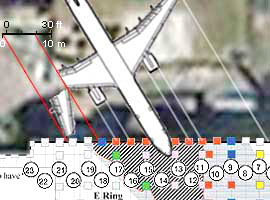
Conclusion
2:
The
Report is able to present no rational support for
its claim that the right engine's hitting a
generator might explain why the outermost part of
the right wing never hit the wall of the
Pentagon.
2.1.3 –0.05 seconds: How
does the Report account for the intact cable
spools in the trajectory of the aircraft?
The
short answer is: in no way. The spools are not
not so much as mentioned despite the fact that
they are conspicuous in numerous photographs
taken at the site, including this one from the
Report (to which numbers of the spools have been
added). With the help of this picture it is
possible to see that the largest spools were 6 to
7 ft tall, for even though they are in the
background of the firemen, the largest ones are
nearly as high in pixels.

What was the exact
location of the spools in relation to the
aircraft's trajectory? The answer to this
question is presented below. The analysis on
which it is based can be found here. (Please also note
my comments on Jim
Hoffman's article (October 2004) in which he refers
to my analysis of the locations of the spools.)
With the real
approach angle (31º) the trajectory of the
fuselage of the aircraft goes over three of the
spools. Would the aircraft have inevitably hit
one or more of the spools?
To answer the question, the
vertical position and tilt of the aircraft as
well as the shape of its underside need to be
taken into account. The answer proves to be
affirmative.

In this figure the aircraft
is tilted to the same angle as in the Report (see
the small inset, ca. 8º), and it is in the
stated height (the top of the fuselage at about
20 ft above ground). The height of the
second-floor slab is also indicated. The
following observations may be made as regards the
spools:
-
There is
definitely space only for the smallest
spool underneath the fuselage. The
largest spool size is too large to fit
under the fuselage. The middle size would
not seem to fit but this must be
considered inconclusive.
-
The Report's
picture (inset): the aircraft is more
than two feet lower, i.e. the top of the
fuselage at no more than 18 ft from the
ground. At this height, not even the
smallest spool would fit under the
fuselage.
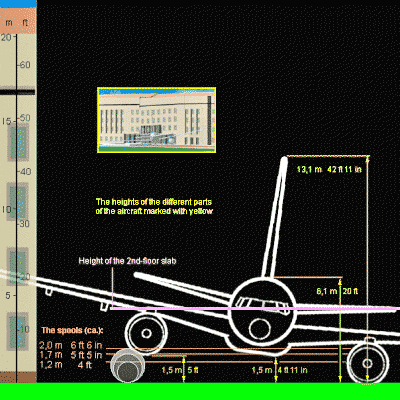
Uncertainties
are naturally involved in an analysis like this:
the height of the spools or the "real"
tilt or height of the aircraft. On the other
hand, the space under the aircraft can be seen
very precisely from documents downloadable from
the Boeing
website.
As regards the only possible approach angle of
31º, spool #4 becomes critical (the one closest
to the building, see the
figure). However, photographs
clearly show that its height is not far from that
of the firemen. Furthermore, the place of spool
#4 was directly in the way of the fuselage.
Of course, the aircraft's
estimated height, based on the images of the
security camera, cannot be considered exact. In
another place the Report says the tail of the
aircraft extended to about 45 ft above ground in
which case the aircraft was roughly two feet
higher than in the diagram - but no less than
four feet higher than in the Reports picture seen
above as the inset. At this greater height, the
aircraft might have barely escaped hitting even
the largest spool.
The difficulty with this is
that it would then be necessary to believe that a
jetliner passed within a few inches of the spool
without causing enough turbulence to overturn it.
In addition, raising the aircraft has negative
consequences on other parts of the official
story, namely for the sliding of almost the whole
aircraft into the first floor and for the already
enormously difficult task of explaining the
facade damage to the right of the impact point.
These are addressed below.
The
height of
the Pentagon is a question of its own. This
measure must be correct if any conclusions
related to vertical parameters of the crash are
to be correct. Nearly all Internet sources
(including the
Pentagon itself) state that the height of the
building is 77 ft 3½ in. Some say 71 ft or
little more (like greatbuildings.com). The correct height of
the facade is, however, most probably 66 ft as in
the above diagram.
[4]
Conclusion
3:
The cable spools show that the
building could not
have been hit by an aircraft with dimensions
similar to those of a Boeing 757 at a vertical
position indicated by the Report.
2.1.4 –0.02 seconds: The
left engine's allegedly hitting a vent structure cannot
account for the narrow facade damage
As can be seen from the quotation above, the eyewitnesses cited in
the Report say the left engine hit a ground-level
vent structure just before the nose of the
aircraft hit the building. Also the height and
tilt information given in the report imply that
the left engine should have hit the ground. It
can be measured from the
impact diagram that this vent structure
must have been some 50 to 70 ft from the fence
and ca. 52 to 85 ft from the building between the
extensions of column lines 14 and 17. In other
words, it must have been somewhere in the area
visible in the firefighters picture below.
The
problem is that no marks left by such an impact
can be seen. They may in vain be sought e.g. from
the Report's
figure showing the cable spools. The
picture below is cropped to show the area to the
left of the spools (the whole photograph can be
seen e.g. here). The
height
diagram
above shows that the 8º tilt shown in the
Report's pictures is not possible given the
vertical position of the aircraft, because the
left engine would plough through the ground.
Assuming a greater distance from the ground or
reducing the tilt would, however, undermine these
claims the Report makes about the actual impact:
the right wing hit the building partly above and
partly below the second floor slab and the left
wing only below it, and the fuselage slipped
under the slab into the first floor. After the
following, final pre-impact conclusion it is time
to turn to the impact itself..

In addition to
the eyewitnesses, there is no material evidence
that the left engine, or any other part of the
left wing, hit anything else before hitting the
building. Therefore, no natural cause can be
presented for the sudden shortening of the left
wing. The facade damage to the left of the impact
point will be returned to below.
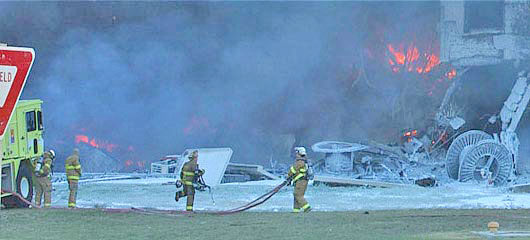
Conclusion
4:
No
support is forthcoming for the claim in the
Report that the left engine hit something prior
to making contact with the facade. Also no
justification is given in the Report for the
allegation that such a hit could even in
principle explain why the outermost part of the
left wing never hit the building.
2.2. The Crash
2.2.1 0.00+ seconds: What makes the
fuselage slide through the 2nd floor slab into the 1st
floor?
The
figure on the right is a schematic presentation
of the impact of a B-757 into the Pentagon wall.
The top of the fuselage is 20 ft from the ground.
The report states as follows (p. 28):

"With the possible exception
of the immediate vicinity of the fuselage’s
entry point at column line 14, essentially all
interior impact damage was inflicted in the first
story: The aircraft seems for the most part to have
slipped between the first-floor slab on grade and the
second floor."
How is it possible that
the fuselage ended up mainly in the first floor? Common
sense tells that he strength of a floor slab
(steel-reinforced concrete) in its own plan is far
greater that that of the nose of an aircraft - especially
after the latter has just hit a limestone-brick-concrete
wall. Furthermore, when it is taken into account that
according to the Report the nose hit the outermost
steel-reinforced concrete column of line 18, nothing
could have been left of the tapering shape of the nose to
cause the alleged sliding into the first floor.
This is
stated in the Report as well: "the front of the
aircraft disintegrated essentially upon impact", p.
40. [5] An immense force would have been
needed to deflect the aircraft to the first floor. The
redirection would have had to take place within a
fraction of a second; there was no damage to the
second-floor slab further than about 40 ft into the
building except for a deflection upward at 70 to 110 ft
from the outer wall (Figure 6.5 on p. 38).
Iif it is assumed that the
reason the aircraft did not hit the cable spools was that
it was actually higher that suggested, even greater
difficulties ensue for explaining why the damage
concentrated almost exclusively in the first floor.
Increasing the height of the aircraft with just a few
feet would mean that the impact was mostly directed at
the second floor. The aircraft had no vertical velocity
but approached horizontally (p. 13).
Conclusion
5:
The
Report's description of the interaction of the
aircraft with the second-floor slab has no
physical credibility.
2.2.2 +0.06 seconds: A hit by the
right engine and wing cannot in any way explain the
facade damage right of the impact hole
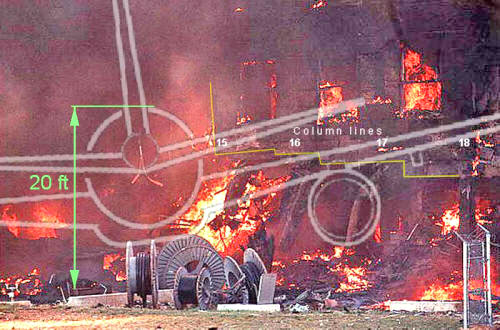
As the impact diagram shows, all facade damage
to the right of column line 15 must be able to be
explained by the hit by the right engine and wing
and the tailplane. The engine should have hit the
wall between column lines 16 and 17 and damage
caused by the tailplane should be visible from
the hole to the right side of column line 17 (which is more accurately seen in the impact diagram). The
picture above was taken by Daryl Donley
just a few minutes after the crash (source: Library
of US Congress, cf. the Report's picture in the
inset in the height diagram).
The picture has been taken roughly along
the aircraft's (31º) trajectory. As can be seen
from the height diagram, accepting the Report's
information of the aircraft's vertical position
and tilt means that the right wing should have 1)
made contact with the slab (whose height is ca.
14 ft from the ground) at the point of the engine
and 2) been above the slab to the right of this
point. The tail plane of the aircraft was clearly
above the slab on the right side of the aircraft.
However, no such damage can
be observed in the (strongly lightened) picture
above; one has to go all the way to the
right side of column line 18 to find impact
damage in the facade above the
second-floor slab. Additionally, the yellow line drawn in the picture
to mark the lower boundary of the facade damage
at column lines 15 to 18 clearly falls to the
right even though the Report says the aircraft
was tilted to the left. Moreover, the exterior
columns of lines 15 to 17 are loose at their
lower ends while the upper ends are still
attached to the second floor (p. 17).
What the
Report calls "gashes" caused by
"impact by the right wing" (p. 28)
between column lines 18 and 20 has been marked
with yellow rectangles (by this author) in the
photographs below. Both pictures are in the
Report.
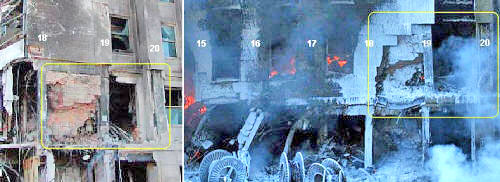
When the wall is examined
in photographs taken prior to the later collapse
(above right), it can be seen that the
second-floor wall left from column line 18 as
well as the outermost column of that line seem to
exhibit no impact damage. It is thus out of the
question to assume that it was the slab which
might have "severed the right wing
approximately at the location of the right
engine" (p. 35). As noted above, the right
engine must have hit the building some 20 ft to
the left of where the slab damage can be seen
(i.e. between column lines 16 and 17). Whatever
hit the wall between column lines 18 and 21 it
was an object ca. 21 to 26 ft wide and it had
already been severed before the impact.
The
exterior column at line 18 is particularly
interesting. As has been shown
above, the Report classifies it
as having "large deformation, with
significant impairment in function". With
the help of the Report's photographs on the
right, one can compare more closely the nature of
the damage to this column before and after the
collapse. Whatever was the cause of the damage,
it was not the crash.
Has the purpose of the said classification been to ridicule the
study, hoping that someone will notice?

Conclusion
6:
The
impact damage to the facade on the right side of
the entry point of the fuselage has nothing to do
with the size, shape and position of the alleged
Boeing 757.
2.2.3 +0.10 seconds [6]: The facade damage to the
left of the fuselage's entry point are
inexplicable by a hit by the left wing
What was the situation on
the left side of the point of impact?
From the
impact diagram it can be seen
that the damage should have extended to
column line 6 (with the Report's approach
angle, to line 5). The photograph on the
right, included in the report, shows that
to the left of column line 8 the damage
is restricted to broken windows and
missing limestone panels. The brick
surface seems undamaged (cf. also Figure
5.7 on p. 26). There is no particular
reason to regard the damage as caused by
the left wing, for the brick surface was
exposed all the way to column line 3 as
can be seen from the bottom picture below
(source:
Pentagon). The Report also
states, as quoted
above, that the the
"tip" of the left wing did not
make contact with the building.
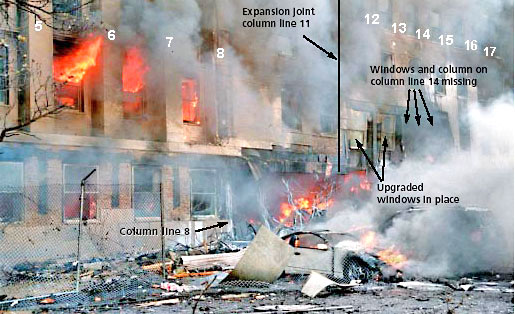

Conclusion
7:
The facade damage to the
left of the entry point of the fuselage
is not suggestive of an impact by a
B-757.
2.2.4 +0.15 seconds: Why doesn't
the tail of the aircraft leave any marks in the facade?
The problem of the official story
as regards the tail of the alleged B-757 is well
summarized in the Report itself (p. 36):

"The
height of the damage to the facade of the building
was much less than the height of the aircraft’s
tail. At approximately 45 ft, the tail height was
nearly as tall as the first four floors of the
building.
Obvious visible damage extended only over
the lowest two floors, to approximately 25 ft above
grade."
With the 8º
tilt used above, the peak of the tail would have been 4-5
ft left from the midpoint of the fuselage; however, at
the height of e.g. the third floor slab (which forms the
top edge of the hole), clearly less than half of that. In
any case, facade damage caused by the tail should be
visible in the photograph on the right (source: U.S. Army
Training and Doctrine Command). There is none.
Additionally,
there can be seen columns at column lines 13 and 14 on
the second floor in the hole created in the facade. The
third floor slab is about 26-27 ft from the ground. It is
very difficult to understand why both the fuselage and
the tail failed to damage it more than can be seen. And,
as the top edge of the facade hole is straight and smooth
it is out of the question that the third floor slab might
have cut the tail off. The possibility of the tail having
been damaged in any way seems also to be excluded by one
of the eyewitnesses interviewed for the report, Mr. Don
Mason: "As the plane entered the building, he
recalled seeing the tail of the plane." (p. 13) This
has major implications for the size of the aircraft that
crashed into the building.
In the
absence of any kind of natural explanation whatsoever,
the lack of damage caused by the tail proves beyond any
reasonable doubt that no aircraft of the size of B-757
hit the building.
Conclusion
8: The
absence of any kind of damage by the aircraft's
tail excludes the possibility of a hit by a
B-757.
2.2.5
+0.81 seconds: Why does the Report evade the
cause of the hole in the inner wall of Ring C?
The Report in no
way comments on what caused a large hole to be
created in the inner wall of the Pentagon's
middle Ring. The Report only says this:
"There
was a hole in the east wall of Ring C,
emerging into AE Drive, between column lines
5 and 7 in Wedge 2 (figure 5.16). The wall
failure was approximately 310 ft from where
the fuselage of the aircraft entered the west
wall of the building."
In addition to
this, the caption and a few pictures, there is
not a word about the hole. Why would a Pentagon
building performance report be silent on the
cause of this "failure?" One could
imagine the hole to be claimed caused by an
engine, but as a matter of fact there is no
mention in the report on what happened to the
aircraft's engines inside the building. On the
spot, it must of course have been visible what
had emerged from the hole. Why are there no
photographs depicting this (round) object? Why is
the official story silent about the matter? A
natural explanation is that the truth is not told
because it cannot be told.

Conclusion
9:
The Report is not able to explain the hole in the
inner wall of Ring C with the story of a crash of
a Boeing 757.
Sensitivity
testing
It is worth
considering if and how uncertainties involved in the
approach angle, point of impact as well as the vertical
position and the tilt of the aircraft may have
implications for the conclusions reached above. The table
below contains those central problems of the official
story which might in principle be alleviated by changes
in the data mentioned. The entries in the table indicate
how the data should be "corrected" in order to
better accommodate the official story. It can be seen
that the possible corrections are few and in part
mutually exclusive.
| |
Point of impact |
Approach angle |
Vertical position |
Tilt |
|
Intact
cable spools |
(Given the holes in the fence and
the facade, these factors cannot be amended
enough to have an effect.) |
Higher |
No
tilt |
|
Slipping
of the aircraft into the first floor |
Hitting
the facade between column lines? |
(No
effect.) |
Lower |
(No
effect) |
|
Slightness
and discontinuity of facade damage right of the
point of impact |
(No effect with any reasonable
amendment.) |
Lower |
Large
tilt to the right |
It should be noted
that the lack any damage caused by the aircraft's tail
remains fully inexplicable regardless of any meaningful
changes in the four variables.
Final Conclusion
The Pentagon
Building Performance Report by the American Society of
Civil Engineers fails in its attempt to show that the
structural damage caused to the Pentagon on Sept. 11,
2001 was caused by a crash by a Boeing 757 aircraft.
Belief in the official B-757 story implies belief in
physically impossible and inexplicable phenomena. More
generally, no proof of the return of Flight 77 to the
Washington area has been presented. On the contrary, e.g.
the security camera recordings that would show what hit
the Pentagon have not been made public for undisclosed
reasons. (A trial has been opened by an individual who wants the videos to be published after the Department of Justice admitted in March 2005 that such videos do still exist. See
www.flight77.info.)
The most
natural explanation for the numerous errors in the Report
is that it is a part of the disinformation campaign by
the US authorities - the purpose of which is to prevent
the truth regarding 9/11 from being revealed and thus to
protect the perpetrators of those atrocities.
References
[1] See pages 3 and 24. The team
leader, Technical Director, US Army Corps of Engineers,
Dr. Paulk E. Mlakar, was in fact allowed to enter the
site as early as Sept. 14, although the Report contains
no account of his early observations. His special area of
expertise is blast-resistant design. He was an
investigator in the Murrah Federal Building Study
(Oklahoma City) after the explosion for which Timothy
McVeigh was executed.
[Back]
[2] The examination of the approach
angle would turn into sheer clownery if Probst's
statement of the wingtip was taken
seriously - unless, of course the wings object that hit
the building were extremely short. Nevertheless, the
Report says the three eyewitnesses - interviewed by Dr.
Mlakar alone, three months after the events -
"collectively provide a coherent and credible
account of the events" (p. 12). (The third
eyewitness was a Rich Fitzharris who did not see the
crash but only the later collapse.)
[Back]
[3] The outer part of the wing
can only have bent forward as a result of the
collision of the engine with the generator. There
has been a sudden backward force applied to the
engine, and the deceleration of the inner part of
the wing has torn the outer part loose. This
event does not seem a realistic option, but it is
examined in order to give the Report every chance
of explaining what happened. [Back]
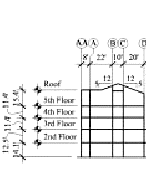  [4] Many of the Report's pictures are
quite blurry. However, the diagram of the floor
heights of the Pentagon (left, only the outermost
ring shown here) is impossible to interpret in
such a manner that it would support either of the
overall heights presented above. If the heights
are read, bottom to top as 14 ft 1 in (this is
stated explicitly in the Report, p. 45), 12 ft 5
in, 11 ft 4 in, 11 ft 4 in and 15 ft 4 in, the
result is 64 ft 6 in, which, however, is
difficult to reconcile with photographs of the
facade. Although the ratios of the heights of
floors 2-4 match, the portion of the building
above the fourth-floor windows seems too high. [4] Many of the Report's pictures are
quite blurry. However, the diagram of the floor
heights of the Pentagon (left, only the outermost
ring shown here) is impossible to interpret in
such a manner that it would support either of the
overall heights presented above. If the heights
are read, bottom to top as 14 ft 1 in (this is
stated explicitly in the Report, p. 45), 12 ft 5
in, 11 ft 4 in, 11 ft 4 in and 15 ft 4 in, the
result is 64 ft 6 in, which, however, is
difficult to reconcile with photographs of the
facade. Although the ratios of the heights of
floors 2-4 match, the portion of the building
above the fourth-floor windows seems too high.
The total height
of the building, or that of the facade, is
nowhere explicitly mentioned in the Report. On
page 36, it says, "At approximately 45 ft,
the tail height was nearly as tall as the first
four floors of the building." This would not
be a meaningful expression if the height of the
building was more than 71 ft, not to mention 77
ft.
Photographs (such
as the one on the right from the Pentagon
site) in
which a giant US flag has been mounted at the top
of the facade provide one means to assess the
height issue. The flag is a so called
"Garrison Flag" whose size is 20 ft by
38 ft (see e.g.
here). If the left edge of the
flag (38 ft) is used as a yardstick and the
effect of the picture having been taken from
above the roof level is ignored, the resulting
facade height is a little less than 65 ft. This
is too low a figure, for at the lower part of the
photograph one pixel stands for more inches than
above.

There is no good photograph
available showing the whole facade as well as the
surface of the ground from a sufficient distance
so that the distortion due to perspective is
minimized.
However, by combining two photographs,
one taken probably from behind Route 27 (source
unfortunately lost) and Figure 5.9 from the
Report as shown on the left, the height question
can be settled with sufficient precision.
The
heights of the floors are from the Report as
interpreted above (bottom to top: as 14 ft 1 in,
12 ft 5 in, 11 ft 4 in, 11 ft 4 in and 15 ft 4
in).
The ca. two-foot discrepancy at the roof
becomes understandable if it is assumed that the
heights are distances of the floor slabs and that
each floor's "own" slab is its floor.
Thus the structures above the bottom surface of
the slab above the fifth floor
are not included in the Report's diagram. In any
case, the second-floor slab is at about 14 ft
above the ground.
[Back]
[5] This can further be illustrated as
follows: If it was possible to hurl a steel-reinforced
concrete slab at an immobile aircraft at a speed of 780
ft/s, would the slab not plane off the upper part of the
fuselage?
[Back]
[6] The post-impact time values must
be considered merely approximate. They have been
calculated using the deceleration of those parts of the
aircraft which traveled the farthest inside the building,
ca. 30g i.e., 966ft/s2. [Back]
|
 [4] Many of the Report's pictures are
quite blurry. However, the diagram of the floor
heights of the Pentagon (left, only the outermost
ring shown here) is impossible to interpret in
such a manner that it would support either of the
overall heights presented above. If the heights
are read, bottom to top as 14 ft 1 in (this is
stated explicitly in the Report, p. 45), 12 ft 5
in, 11 ft 4 in, 11 ft 4 in and 15 ft 4 in, the
result is 64 ft 6 in, which, however, is
difficult to reconcile with photographs of the
facade. Although the ratios of the heights of
floors 2-4 match, the portion of the building
above the fourth-floor windows seems too high.
[4] Many of the Report's pictures are
quite blurry. However, the diagram of the floor
heights of the Pentagon (left, only the outermost
ring shown here) is impossible to interpret in
such a manner that it would support either of the
overall heights presented above. If the heights
are read, bottom to top as 14 ft 1 in (this is
stated explicitly in the Report, p. 45), 12 ft 5
in, 11 ft 4 in, 11 ft 4 in and 15 ft 4 in, the
result is 64 ft 6 in, which, however, is
difficult to reconcile with photographs of the
facade. Although the ratios of the heights of
floors 2-4 match, the portion of the building
above the fourth-floor windows seems too high. 




 In
the picture on the right the B-757's location and
approach angle are the same as in the Report's
picture seen
In
the picture on the right the B-757's location and
approach angle are the same as in the Report's
picture seen 













